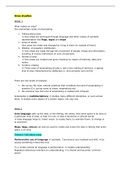Area studies
Week 1
What makes an area?
Five elementary kinds of areamaking:
1. Talking about area
How areas are portrayed through language and other means of symbolic
representation like flags, logos and maps.
2. Areas of abode
How areas are made and changed by living in them (or outside of them)
3. Mobility, circulaation, distribution
How areas are made through the movement of people, things and information,
including of course restrictions on such movements.
4. Stories of area
How areas are created and given meaning by means of histories, tales and
myths.
5. Territory making
These ways of areamaking all play a role in the making of territory; a special
kind of area characterized by deliberate in- and exclusion and control.
There are two levels of analysis:
1. We survey the main cultural practices that constitute the kind of areamaking in
question (f.e. giving name to areas, mapmaking etc)
2. We examine how this kind of areamaking is studied and critiqued.
Areastudies is multidisciplinary: it studies many different disciplines, or even across
them. It studies every aspect of a certain region, not only one.
Week 2
Area language calls up the idea, or the feeling, the sense, that some space is an area or
a particular kind of area, or that it is not, or that it should be or should not be
Area language helps to ‘make’ areas: to create them, to maintain them, to change or
to end them.
Maps, flags, colours can also be used to create and evoke the idea or feeling that some
space is an area.
Theme I: Talk about areas
Performative use of language example: ‘I pronounce you husband and wife’ by
saying something it becomes true.
To a certain extend all language is performative: it creates understanding.
Repeated utterances maintain an understanding, it is shared and becomes ‘common
sense’.
, Area is not necessarily on land: it can be in the air, in the sea, it can be virtual or
mythological.
What aspects of ‘area’ are fundamental tot his course?
An area is a space with a center (core/heart) and/or borders
There are certain characteristics to an area, there is a certain identity
An area is (almost always) subject to power/ownership or some sort of control
Not all areas used to have clear borders ancient Egypt: there were clear centers, but
the surroundings were kind of ‘no one’s land’.
Clear borders are relatively recent and a very European way of area making.
Often area names identify certain characteristics
Sometimes it represents a dominant ethnic group.
f.e: England (from the Angles)
Sometimes it is a political tool.
f.e: Thailand (named after the Thai people, which was the most dominant group)
Important political ideologies linked to kinds of areas or particular areas:
-Nationalism
-Regionalism
-Pan-Asianism
-Pan-Arabism
-Globalism
-Ethnicism ( prefering a certain ethnicity)
Ancient Egypt Article: Moers 2010, “The world and the
geography of otherness in pharaonic Egypt
The Egyptians considered their country the center of
the universe
For this, the Pharaoh was the ruler of the whole
world: Egypt = the world.
The ‘other’/’outside their world’ was seen as
fascinating but yet dangerous.
Example: Pharaoh smiting the enemy this scene
shows the Pharaoh beating foreign people who beg
him for mercy.





